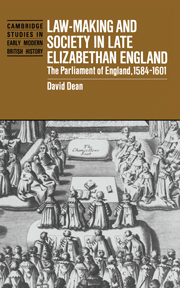Book contents
- Frontmatter
- Contents
- Acknowledgements
- Note to the reader
- List of abbreviations
- Introduction
- 1 Initiation and procedure
- 2 Supply and the general pardon
- 3 The crown and the state
- 4 Religion and the church
- 5 The commonweal
- 6 Law reform
- 7 Private legislation
- 8 Expiring laws continuance acts
- Epilogue: the Parliament of 1604
- Conclusion
- Index of acts
- Index of bills
- General index
5 - The commonweal
Published online by Cambridge University Press: 14 September 2009
- Frontmatter
- Contents
- Acknowledgements
- Note to the reader
- List of abbreviations
- Introduction
- 1 Initiation and procedure
- 2 Supply and the general pardon
- 3 The crown and the state
- 4 Religion and the church
- 5 The commonweal
- 6 Law reform
- 7 Private legislation
- 8 Expiring laws continuance acts
- Epilogue: the Parliament of 1604
- Conclusion
- Index of acts
- Index of bills
- General index
Summary
Englishmen vied for the limited parliamentary time available to obtain legislation dealing with economic and social matters. More bills of this type were initiated than any other and they took up a good deal of time partly because of the sheer number involved and partly because they could be very contentious. Measures beneficial to one economic interest all too often had considerable disadvantages for another and a statute might well provoke later of bills of alteration, clarification or repeal. The economic difficulties of the 1590s stimulated legislative impulses; 1597–8 and 1601 saw an especially large number of measures introduced seeking to cure social ills or regulate the economy.
INDUSTRY, TRADE AND COMMERCE
Textiles
More bills concerned the cloth industry than any other economic activity. Most attempted to alter, revise and change key statutes of 1552 and 1558, or to secure exemption from the regulations they imposed. Many were intended to protect specific manufactures or regional interests but there were two key developments over the course of the sixteenth century which provided the context in which these particular games were played out. The first was the decline of some of the more traditional, highly durable but heavier woollen cloths and the expanding production of dressed cloths such as kerseys and the new draperies such as baize and fustians. The other was the conflicting interests of the Merchant Adventurers who dominated the export trade in unfinished cloth and the Clothworkers’ Company who were anxious to secure work for their members in the finishing trade.
- Type
- Chapter
- Information
- Law-Making and Society in Late Elizabethan EnglandThe Parliament of England, 1584–1601, pp. 133 - 187Publisher: Cambridge University PressPrint publication year: 1996
- 1
- Cited by

